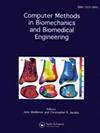用于脑电图信道选择的零精度损失框架:提高效率并保持可解释性
IF 1.7
4区 医学
Q3 COMPUTER SCIENCE, INTERDISCIPLINARY APPLICATIONS
Computer Methods in Biomechanics and Biomedical Engineering
Pub Date : 2024-09-13
DOI:10.1080/10255842.2024.2401918
引用次数: 0
摘要
基于运动图像的脑机接口(BCI)系统通常依靠大量的电极通道来获取信息。如何合理选择脑电图(EE)通道?本文章由计算机程序翻译,如有差异,请以英文原文为准。
A zero precision loss framework for EEG channel selection: enhancing efficiency and maintaining interpretability
The brain-computer interface (BCI) systems based on motor imagery typically rely on a large number of electrode channels to acquire information. The rational selection of electroencephalography (EE...
求助全文
通过发布文献求助,成功后即可免费获取论文全文。
去求助
来源期刊
CiteScore
4.10
自引率
6.20%
发文量
179
审稿时长
4-8 weeks
期刊介绍:
The primary aims of Computer Methods in Biomechanics and Biomedical Engineering are to provide a means of communicating the advances being made in the areas of biomechanics and biomedical engineering and to stimulate interest in the continually emerging computer based technologies which are being applied in these multidisciplinary subjects. Computer Methods in Biomechanics and Biomedical Engineering will also provide a focus for the importance of integrating the disciplines of engineering with medical technology and clinical expertise. Such integration will have a major impact on health care in the future.

 求助内容:
求助内容: 应助结果提醒方式:
应助结果提醒方式:


